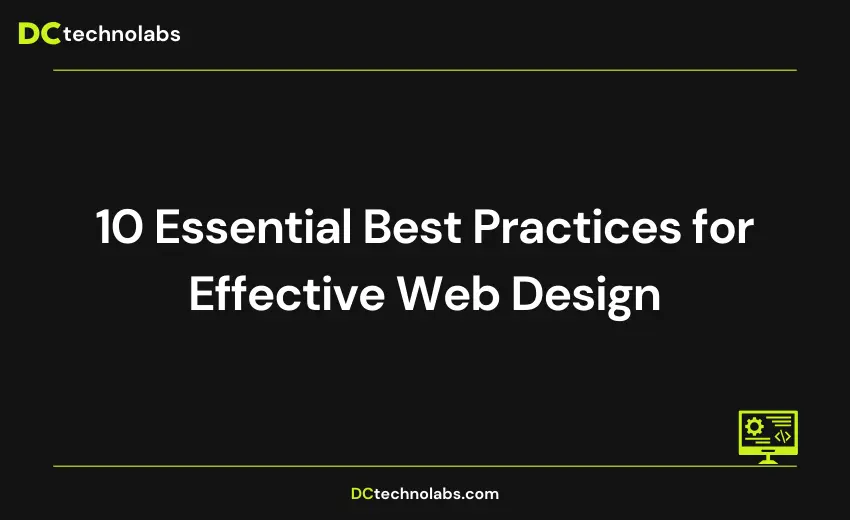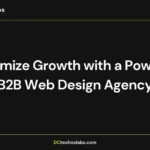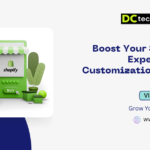
Are you looking to create a website that captivates your audience and converts visitors into customers? Effective web design is the key to achieving this goal. In this article, we will explore the top 10 essential best practices for creating a website that not only looks great but also drives results.
From easy navigation to responsive design, these practices will ensure that your website is user-friendly and accessible across all devices. We will look into the importance of clean and organized layouts, compelling visuals, and captivating content that connected with your target audience.
By implementing these best practices, you can optimize your website for search engines, improve user experience, and ultimately boost conversions. Whether you are a seasoned web designer or just starting out, these tips will provide you with valuable insights to take your website to the next level.
So, if you are ready to improve your web design skills and create a website that leaves a lasting impression on your visitors, let’s dive into these 10 essential best practices.
Table of Contents
- 1. Importance of Effective Web Design
- 2. Understanding the Needs of Your Target Audience
- 3. Clear and Intuitive Navigation
- 4. Ensuring Mobile Responsiveness
- 5. Utilizing Whitespace Effectively
- 6. Consistent Branding and Visual Elements
- 7. Optimizing Page Load Speed
- 8. Incorporating Call-to-Action Buttons
- 9. Aesthetically Pleasing and Engaging Visuals
- 10. Regularly Testing and Optimizing Your Website
1. Importance of Effective Web Design
Effective web design is the basis of a successful online presence. In today’s digital landscape, a well-designed website can make all the difference in how your business is considered and how effectively it engages with its target audience. A visually appealing, user-friendly, and strategically crafted website can be a powerful tool for attracting and retaining customers, driving conversions, and ultimately, achieving your business goals.
A website that is poorly designed, difficult to navigate, or slow to load can quickly turn off visitors and damage your brand’s credibility. On the other hand, a website that represents best practices in web design can create a positive and lasting impression, making it more likely that visitors will engage with your content, explore your offerings, and ultimately, convert into customers or loyal followers.
Effective web design is not just about appearances– It is a complete discipline that includes user experience, search engine optimization (SEO), accessibility, and more. By incorporating these elements into your website, you can create a digital platform that not only looks great but also delivers tangible business results. Whether you’re launching a new website or revamping an existing one, understanding and implementing the essential best practices of web design is crucial for your online success.
2. Understanding the Needs of Your Target Audience
Before you can create an effective web design, it’s essential to have a deep understanding of your target audience. Who are the people you’re trying to reach, and what are their needs, preferences, and pain points? By addressing these key questions, you can tailor your website to provide to the specific requirements of your target audience, making it more likely that they will engage with your content and take the desired actions.
Conducting thorough market research, creating user profiles, and analyzing user behavior data can provide valuable insights into your target audience. This information can help you determine the type of content, features, and functionality that will connected most with your visitors, as well as the design elements that will create an optimal user experience.
For example, if your target audience are mostly mobile users, you’ll need to ensure that your website is highly responsive and optimized for small screens. On the other hand, if your target audience is more technologically adept and values cutting-edge design, you may want to incorporate more innovative and visually unique design elements. By aligning your web design with the needs and preferences of your target audience, you can create a website that not only looks great but also drives meaningful engagement and conversions.
3. Clear and Intuitive Navigation
One of the most critical aspects of effective web design is creating a clear and easy navigation system. Your website’s navigation should be easy to understand, allowing visitors to quickly find the information or content they’re looking for without getting lost or frustrated.
A well-designed navigation menu should be strategically placed, using clear and simple labels that accurately reflect the content and structure of your website. It should be consistent across all pages, ensuring that users can easily navigate from one section to another without having to redirect themselves.
In addition to a well-designed navigation menu, you should also consider incorporating other navigational elements, such as breadcrumbs, search functionality, and internal linking. These features can further enhance the user experience by providing additional context and making it easier for visitors to explore your website’s content.
By prioritizing clear and easy navigation, you can reduce the bounce rate on your website, increase the time spent by visitors, and ultimately, improve the likelihood of conversions. Remember, a confusing or difficult-to-navigate website can be a major preventative for potential customers, so investing in a thoughtful and user-friendly navigation system is essential for effective web design.
4. Ensuring Mobile Responsiveness
In today’s digital landscape, where mobile devices have become the primary means of accessing the internet, ensuring that your website is mobile-responsive is a crucial best practice for effective web design. A Mobile-Responsive Website is one that automatically adapts to the screen size and direction of the device being used, providing an optimal viewing and interaction experience for the user.
With the increasing frequency of smartphones and tablets, a significant portion of your target audience is likely accessing your website on the go. If your website is not optimized for mobile devices, it can result in a poor user experience, such as difficult-to-read text, misaligned or overlapping elements, and the need for excessive scrolling or zooming. This can lead to high bounce rates, lower engagement, and ultimately, a negative impact on your business.
Implementing a mobile-responsive design involves more than just scaling down the content to fit smaller screens. It requires a thoughtful approach to layout, content prioritization, and user interaction, ensuring that the website remains natural and easy to navigate, regardless of the device being used. This may involve simplifying the navigation menu, optimizing images and media for faster loading times, and prioritizing the most important content and calls-to-action.
By ensuring that your website is mobile-responsive, you can provide a seamless and consistent user experience across all devices, improve your search engine rankings (as Google now prioritizes mobile-friendly websites), and ultimately, increase the possibility of conversions and customer loyalty. Poor mobile responsiveness in your web design can be a costly mistake, so it’s essential to make it a top priority.
5. Utilizing Whitespace Effectively
Whitespace, also known as negative space, is an often overlooked but critical element of effective web design. Whitespace refers to the areas of a web page that are left empty, without any content or visual elements. While it may seem illogical, the strategic use of whitespace can greatly enhance the overall aesthetics and usability of your website.
Effective use of whitespace can help to create a sense of balance, hierarchy, and focus on your web pages. By strategically placing whitespace around and between elements, you can draw the viewer’s attention to the most important content, reduce visible complexity, and create a clean and professional-looking design with UI/UX Design.
Whitespace can also improve the readability and clarity of your website’s content. By providing sufficient spacing between lines of text, paragraphs, and sections, you can make the content easier to scan and digest, reducing the mental load on your visitors. This can be particularly important for websites with large amounts of text or complex layouts.
Moreover, the effective use of whitespace can enhance the overall user experience by making your website feel more organized, creative, and visually appealing. This can ultimately lead to increased engagement, reduced bounce rates, and higher conversion rates, as visitors are more likely to stay on your website and explore its content.
6. Consistent Branding and Visual Elements
Consistent branding and visual elements are essential for creating a creative and memorable web design. Your website should reflect your brand’s identity, personality, and values, ensuring that visitors instantly recognize and associate your online presence with your business.
This consistency should be obvious in various aspects of your web design, including your color scheme, typography, imagery, and overall aesthetic. By maintaining a consistent visual language across your website, you can boost your brand’s identity and create a sense of familiarity and trust with your audience.
Consistent branding and visual elements also play a crucial role in enhancing the user experience. When visitors navigate through your website, they should feel a sense of consistency and familiarity, which can make them more comfortable and ready to engage with your content and offerings. This can also improve the overall aesthetic appeal of your website, making it more visually appealing and memorable.
Furthermore, consistent branding and visual elements can have a positive impact on your Search Engine Optimization (SEO) efforts. Search engines often prioritize websites that have a strong and consistent brand identity, as it signals to them that the website is authentic, trustworthy, and relevant to the user’s search query.
By investing time and effort into creating a solid and visually appealing brand identity for your website, you can differentiate yourself from your competitors, build brand recognition, and ultimately, drive more meaningful engagement and conversions from your target audience.
7. Optimizing Page Load Speed
In the fast-paced digital age, the speed at which your website loads is a critical factor in its overall effectiveness. Slow-loading pages can frustrate visitors, leading to high bounce rates, decreased engagement, and ultimately, lost business opportunities.
Optimizing your website’s page load speed is a crucial best practice for effective web design. A fast-loading website not only provides a better user experience but also has a positive impact on your search engine rankings, as Google and other search engines prioritize websites with faster load times.
There are several techniques you can employ to optimize your website’s page load speed, such as:
- Compressing and optimizing images and other media files
- Minimizing the use of large, high-resolution images or videos
- Utilizing browser caching to reduce the need for repeated downloads
- Optimizing and minifying your website’s code (HTML, CSS, JavaScript)
- Implementing a content delivery network (CDN) to serve your website’s assets from a geographically closer location
- Reducing the number of third-party scripts and plugins used on your website
By implementing these and other page speed optimization strategies, you can ensure that your website loads quickly and efficiently, providing a seamless user experience and improving your overall web design effectiveness.
8. Incorporating Call-to-Action Buttons
Call-to-action (CTA) buttons are a crucial element of effective web design, as they guide your visitors towards the desired actions you want them to take, such as making a purchase, signing up for a newsletter, or contacting your business.
Effective CTA buttons are strategically placed, visually noticeable, and have clear and compelling copy that encourages the user to take the next step. They should be designed to stand out from the surrounding content, using contrasting colors, eye-catching shapes, and interesting language that connected with your target audience.
In addition to the design and placement of your CTA buttons, it’s essential to ensure that they lead to a smooth and smart user experience. When a visitor clicks on a CTA button, they should be taken to a relevant and well-designed landing page or form that continues the momentum and guides them through the conversion process.
By incorporating well-designed and strategically placed CTA buttons throughout your website, you can effectively guide your visitors towards the actions that are most valuable to your business, ultimately driving higher conversion rates and achieving your marketing goals.
9. Aesthetically Pleasing and Engaging Visuals
In the world of web design, the visual elements of your website play a crucial role in capturing the attention and interest of your target audience. Aesthetically pleasing and engaging visuals can create a lasting impression, convey your brand’s personality, and enhance the overall user experience.
When it comes to effective web design, visual elements such as high-quality images, eye-catching graphics, and thoughtfully designed layouts can make a significant impact. Well-chosen visuals can help to break up text-heavy content, highlight important information, and create a visually appealing and memorable website.
Moreover, the use of engaging visuals can also improve the user experience by making your website more visually stimulating and easier to navigate. Strategically placed images, icons, and other visual elements can help guide the user’s attention, making it easier for them to find the information they’re looking for and encouraging them to explore your website further.
To ensure that your website’s visuals are effective, it’s essential to consider factors such as image quality, color scheme, and overall visual integration. By aligning your visual elements with your brand’s identity and the preferences of your target audience, you can create a website that is not only visually appealing but also effectively communicates your message and drives conversions.
10. Regularly Testing and Optimizing Your Website
Effective web design is an ongoing process, and it’s essential to regularly test and optimize your website to ensure that it continues to meet the needs of your target audience and achieve your business goals. Regular testing and optimization can help you identify areas for improvement, address any issues or pain points, and continuously enhance the user experience.
There are a variety of testing and optimization techniques you can employ, including:
- A/B testing: Comparing different variations of your website’s design, content, or functionality to determine which performs better.
- Usability testing: Observing how users interact with your website and identifying any pain points or areas for improvement.
- Analytics and data analysis: Monitoring your website’s performance metrics, such as bounce rate, time on site, and conversion rates, to identify opportunities for optimization.
- Mobile testing: Ensuring that your website is optimized for mobile devices and providing a seamless user experience across all devices.
By regularly testing and optimizing your website, you can make informed decisions about the changes and improvements that will have the greatest impact on your target audience and your business objectives. This adaptive process can help you stay ahead of the curve, adapt to changing user preferences, and maintain a competitive edge in the ever-evolving digital landscape.
Remember, effective web design is not a one-time activity– it’s an ongoing journey of continuous improvement and refinement. By embracing a culture of testing and optimization, you can ensure that your website remains relevant, engaging, and effective in driving your business forward.
Conclusion
In conclusion, incorporating Web Design Best Practices is Important for creating a website that attracts your audience and converts visitors into customers. By strategically placing whitespace around and between elements, you can draw the viewer’s attention to the most important content, reduce visible complexity, and create a clean and professional-looking design.
Are you looking to create a website that leaves a lasting impression? Appreciate these practices and let DC Technolabs help you achieve your goals. Contact us today to learn more about how we can support your web design and development needs.
If you found this blog helpful, check some of the other blogs below:
- Ultimate Guide to Hiring a Top Small Business Web Design Agency
- Maximizing Business Growth: The Power of a B2B Web Design Agency
For more insights and updates on web design for small businesses, follow us on Instagram, Facebook, LinkedIn, and Twitter.






